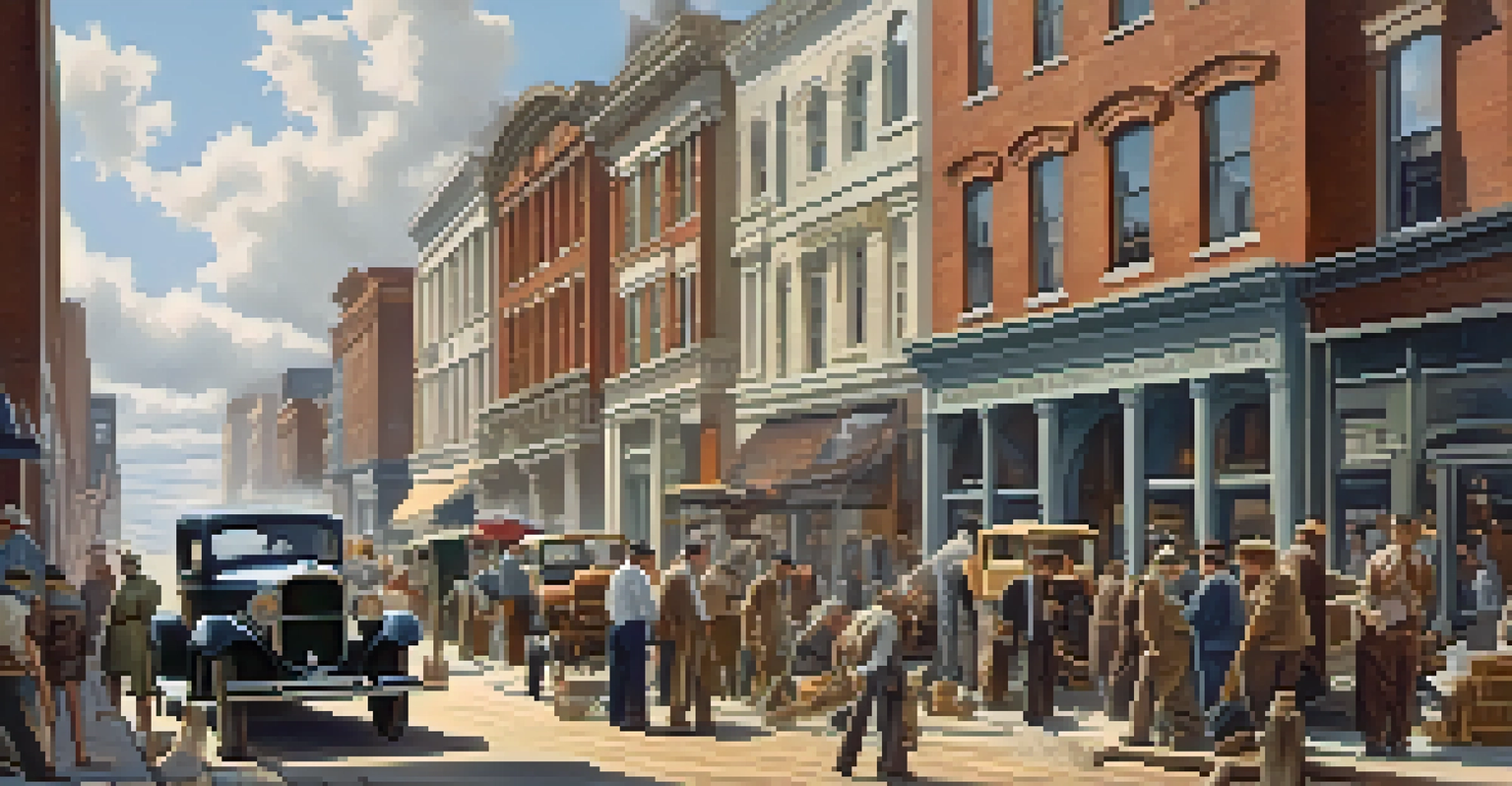Significant Historical Events in Washington's Development

The Founding of Washington: A New Capital Emerges
In 1790, the U.S. Congress selected the site for the nation's capital, Washington, D.C., strategically located along the Potomac River. This decision was part of a compromise to satisfy both northern and southern states, reflecting the political dynamics of the young nation. The vision was to create a capital that symbolized democracy and unity, separate from the influence of any single state. Pierre L'Enfant, appointed by George Washington, designed the city, incorporating grand boulevards and open spaces, paving the way for future development.
Washington is a city of southern efficiency and northern charm.
The selection of Washington as the capital marked a pivotal moment in American history, as it demonstrated a commitment to a federal government that represented all states equally. It was a bold move, emphasizing the importance of a central location that was not tied to any existing state power. The establishment of the capital also stimulated economic growth in the surrounding areas, leading to a population boom and infrastructure development that would shape the city's identity.
Over the years, Washington has evolved from a fledgling city into a vibrant metropolis. The historical significance of its founding continues to resonate, as the capital remains a center of political power and cultural influence. This early decision laid the groundwork for the city’s future, merging history with the ongoing narrative of American governance.
The Civil War: A Turning Point for Washington
The Civil War, which erupted in 1861, had a profound impact on Washington, D.C., as it transformed from a political hub to a strategic military center. The city was surrounded by Confederate territory, making it crucial for the Union to reinforce its defenses. As a result, Washington saw an influx of troops, construction of forts, and the establishment of hospitals, fundamentally altering its landscape and demographics.

During the war, Washington was not just the political heart of the Union; it also became a focal point for social change. The conflict intensified debates over slavery and civil rights, leading to significant legislative changes, including the Emancipation Proclamation in 1863. This shift in policy and ideology echoed through the streets of Washington, fostering a sense of urgency for equality and justice that would resonate long after the war ended.
Washington's Strategic Founding
In 1790, the selection of Washington, D.C., as the U.S. capital was a crucial compromise that symbolized unity and democracy.
The aftermath of the Civil War left Washington with a legacy of resilience and transformation. The city emerged with new infrastructure and a renewed spirit, laying the foundation for its role as a leader in civil rights movements in the years to come. The war's influence is still evident in Washington today, reminding us of its critical role in shaping the nation's values.
The New Deal: Washington's Role in Economic Recovery
The Great Depression of the 1930s brought significant economic challenges to the United States, prompting the government to implement the New Deal. Washington, D.C., was at the forefront of this initiative, as the federal government sought to revitalize the economy through public works projects and job creation. The city itself benefited from various programs that improved infrastructure, parks, and public buildings, significantly enhancing its appeal and functionality.
The greatness of a nation and its moral progress can be judged by the way its animals are treated.
As part of the New Deal, the Works Progress Administration (WPA) and other agencies employed thousands of workers in Washington. These projects not only provided immediate economic relief but also left a lasting impact on the city's landscape. Iconic structures, like the National Gallery of Art, were constructed during this period, showcasing the intertwining of art and architecture with the nation’s recovery efforts.
The New Deal era reshaped Washington's identity, emphasizing the role of government in economic and social welfare. This period laid the groundwork for future federal initiatives aimed at improving the quality of life for citizens. Today, the remnants of this transformative time can still be seen in the city’s architecture and community programs, underscoring Washington's ongoing evolution.
Civil Rights Movement: Washington as a Stage for Change
The Civil Rights Movement of the 1960s turned Washington, D.C., into a pivotal stage for social justice and equality. Iconic events, like the March on Washington for Jobs and Freedom in 1963, drew massive crowds and highlighted the demands for civil rights. Martin Luther King Jr.'s famous 'I Have a Dream' speech, delivered at the Lincoln Memorial, resonated with millions and underscored the significance of Washington in the fight for equality.
This era saw the city's role expand beyond politics; it became a symbol of hope and change for marginalized communities. The activism in Washington catalyzed legislative changes, including the Civil Rights Act of 1964 and the Voting Rights Act of 1965, which aimed to dismantle systemic racism and ensure equal rights for all citizens. These landmark laws were a direct result of the relentless efforts of activists who gathered in the capital to demand justice.
Civil Rights Movement's Impact
The 1960s Civil Rights Movement transformed Washington into a pivotal stage for social justice, leading to significant legislative changes.
Washington’s legacy as a center for civil rights advocacy continues to inspire movements today. The city not only reflects the struggles of the past but also serves as a backdrop for ongoing dialogues about equality and justice. The echoes of the Civil Rights Movement remind us of the power of collective action in shaping a more equitable society.
The Watergate Scandal: A Crisis of Trust in Government
The Watergate scandal in the early 1970s profoundly impacted Washington, D.C., and the nation’s trust in government. It began with a break-in at the Democratic National Committee headquarters and unfolded into a complex web of political corruption and abuse of power at the highest levels. As investigations revealed the extent of the wrongdoing, Washington became synonymous with a crisis in political integrity.
The scandal led to a series of hearings and investigations that captivated the nation. Televised testimonies exposed the inner workings of the government, and the public watched as key figures, including President Nixon, were implicated. This transparency brought to light the importance of accountability and the role of the press in a democratic society, reshaping the relationship between the government and its citizens.
Ultimately, the Watergate scandal resulted in Nixon's resignation in 1974, marking a significant moment in American history. It served as a wake-up call for the nation, prompting reforms aimed at increasing transparency and reducing governmental overreach. The lessons learned from this scandal continue to influence political discourse and public trust in Washington today.
Post-9/11: Security and Transformation in Washington
The events of September 11, 2001, transformed Washington, D.C., and reshaped its national security policies and urban landscape. As the capital became a target for terrorism, security measures tightened dramatically, leading to visible changes throughout the city. Increased police presence, surveillance, and security checkpoints became the new norm, reflecting a heightened awareness of vulnerability.
In response to the attacks, the U.S. government implemented various initiatives to bolster national security. The creation of the Department of Homeland Security and the implementation of the Patriot Act altered the way Washington operated, prioritizing safety while balancing civil liberties. This period marked a shift in public perception, with citizens becoming more aware of global issues and their implications for domestic life.
Modern Washington's Cultural Hub
Today, Washington, D.C., thrives as a vibrant center of innovation and culture, blending historical significance with contemporary expression.
Despite the challenges, Washington also experienced a renaissance in civic engagement and community resilience. The aftermath of 9/11 saw citizens rallying together, fostering a renewed sense of patriotism and solidarity. The city’s ongoing evolution illustrates its ability to adapt in the face of adversity, reflecting the spirit of resilience that has characterized Washington throughout its history.
Modern Washington: A Hub of Innovation and Culture
Today, Washington, D.C., stands as a vibrant hub of innovation and culture, reflecting the diverse tapestry of its residents. The city is not only the political center of the United States but also a thriving ecosystem for tech startups, non-profits, and cultural institutions. With a focus on innovation, Washington has drawn in a new generation of thinkers, creators, and leaders who are shaping its future.
Culturally, Washington boasts a rich array of museums, theaters, and art galleries that celebrate its historical significance while promoting contemporary expressions. Institutions like the Smithsonian and the Kennedy Center not only preserve the past but also serve as platforms for modern artists and thinkers. This blend of history and innovation creates a unique atmosphere where tradition meets progress.

As Washington continues to evolve, it reflects the changing dynamics of American society. The city’s ability to adapt and grow while honoring its historical roots positions it as a beacon of hope and inspiration. With each passing year, Washington embraces new challenges and opportunities, ensuring its legacy remains vibrant and relevant for generations to come.